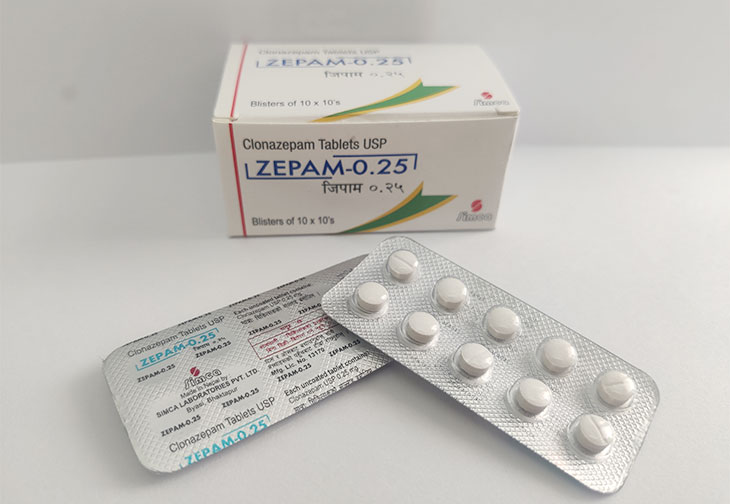ZEPAM 0.25 mg Tablets
Generic name: Clonazepam
Drug class: Benzodiazepines
Dose available: 0.25mg and 0.5mg tablets
General information:
Clonazepam is an Benzodiazepines with prominent anticonvulsant properties indicated for the treatment of panic disorder, with or without agoraphobia.
Pharmacokinetics:
Absorption: rapidly and completely absorbed after oral administration
Bioavailability: ~ 90%
Tmax: 1-4 hours
Distribution: 85% bound to plasma protein
Metabolism: highly metabolized, hepatic metabolism
Elimination: via urine with 2 % unchanged
Half life: 30-40 hours
Mechanism of action: The precise mechanism by which clonazepam exerts its antiseizure and antipanic effects is unknown, although it is believed to be related to its ability to enhance the activity of gamma aminobutyric acid (GABA), the major inhibitory neurotransmitter in the central nervous system resulting in calming effect.
Indication:
- Seizure disorder: Absence seizure with or without Lennox-Gastaut syndrome
Monotherapy or adjunct in the treatment of the Lennox-Gastaut syndrome (petit mal variant), akinetic and myoclonic seizures. In patients with absence seizures (petit mal) who have failed to respond to succinimides, Clonazepam is helpful.
- Adjuvant in myoclonic seizure
- Anxiety disorder
- Panic disorder
- Bipolar disorder, mixed or maniac episodes
- REM sleep behavior disorder
- Tardive dyskinesia
Dosage and administration:
Seizure disorder (Adults): Initial dose should not exceed 1.5mg/day as TID, dose may be increased from 0.5mg to 1 mg until seizures are adequately controlled.
(Pediatrics): 0.01-0.03 mg/kg/day BD/TID
Panic disorder: 0.25mg OD/BD
Dose adjustment:
- Hepatic impairment: No dose adjustment required
- Renal impairment: No dose adjustment required
Adverse Drug Reaction:
Drowsiness, ataxia, behavioural problems, dizziness, fatigue, constipation, abdominal pain, anorexia, myalgia, blurred vision
Drug-Drug Interaction:
- Clonazepam may increase the levels/effects of alcohol, CNS depressants, Flunitrazepam,SSRIs, Opioids, Mirtazapine, Pra,ipexole, Ropinirole, Zolpidem
- The levels/effects of Clonazepam may be increased by Cannabidiol, Doxylamine, Hydroxyzine, Lofexidine, Magnesium sulphate, Mifepristone, Minocycline, Olanzapine, Palbociclib, Tapentadol, Vigabatrin
- The levels/effects of Clonazepam may be decreased by Phenytoin, Fosphenytoin, Theophylline, Tocilizumab, Siltuximab
- Concurrent administration of clonazepam and valproate is contraindicated because absence status may be precipitated.
Precaution and warnings:
- Concomitant administration with Opioids may result in profound sedation, respiratory deression
- Potentiation of sedation from concomitant use with CNS depressants
- Patient who are risk of falls
- Patient with history of drug abuse or alcoholism
Contraindication: History of hypersensitivity to the drug or its ingredients. Hypersensitivity reactions have included serious dermatological reactions
Pregnancy Category: ‘D
Advantages:
- Superior safety profile compared to other Benzodiazepines
- Indicated in patients with Absence seizure (Petil mal) who have failed to respond to succinimides
- Used in combination with anti-psychotics for the treatment of mania or acute psychosis-induced aggression, when urgent sedation is required
- Clonazepam has more marked muscle relaxant property compared with other BZDs
- Clonazepam have more prominent anticonvulsant activity than other BZDs


